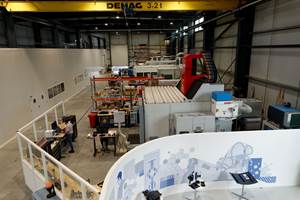IRG CosiMo thermoplastic composites consortium unveils new facilities
IRG CosiMo combines companies along the whole thermoplastic composites process chain from materials to processing machinery to applications in automotive and aerospace.
IRG CosiMo new facilities and first piece of equipment were unveiled in Augsburg, Germany during an Opening Ceremony on Sept. 28.
These new infrastructures were set up less than two months after Faurecia Clean Mobility (Nanterre, France), Premium AEROTEC (Augsburg, Germany), Solvay (Alpharetta, GA, US) and ENGEL (Schwertberg, Austria) started IRG CosiMo (Industry Research Group: Composites for Sustainable Mobility), the industry’s first private consortium focusing on the development of thermoplastic materials and process technologies in aerospace and automotive.
The first piece of equipment is a 1000 MT press with tool handling system complemented by different equipment for thermoplastic processing. The press will be part of a full production line financed by the consortium.
Dr. Thomas Ehm, CEO of Premium Aerotec states, “This project is key for the next technological step in designing and producing modern fuselages. We will not only research the application of this material but also investigate how a modern digitalized factory will look like.”
“Thermoplastic composites offer distinct advantages around forming, joining, design, functionality and economics. Success factors such as cost reduction, scalability to high volume and production of larger parts still need to reach industrial scale. IRG CosiMo was set up to address these,” says Fabrizio Ponte, vice president of Strategy, Business Development and Communication for Solvay Composite Materials global business unit.
IRG CosiMo is unique as it combines companies along the whole thermoplastic composites process chain, from the materials and semi-finished products (Solvay) followed by specially adapted processing machinery (ENGEL) to applications in automotive (Faurecia) and aerospace (Premium Aerotec). Project organization will be facilitated by ITA Augsburg (Augsburg, Germany).
“We are proud to have helped to organize the project and expect major effects of synergies between automotive and aerospace for new products like drones or air taxis in high volume applications,” says Prof. Dr. Stefan Schlichter, managing director of ITA Augsburg.
IRG CosiMo says it is open to integrating new partner companies and to collaborating with institutes of the research campus Augsburg — Augsburg University, DLR-ZLP, Fraunhofer IGCV — to jointly develop critical complementary aspects such as digitalization, material research and parts functional design.
In the technology center Augsburg (TZA) the consortium has found a place where joint research can be conducted and where the machines for the technology platform can be installed.
“In order to cover the demand in lightweight technology of both, the automotive industry as well as the aviation industry, we need to consider modular concepts for the processing, where also sophisticated data handling is managed,” emphasized Dr. Norbert Müller, head of the ENGEL’s center for lightweight composite technologies.
Premium AEROTEC, Faurecia and ITA Augsburg are also part of a large project consortium which is funded in frame of the Campus Carbon 4.0 program of the Free State of Bavaria. This project called CC4.0 CosiMo aims for developing new materials and processes using in-situ polymerization of Polyamide 6 from Caprolactam for high volume applications in the automotive sector.
Hassine Sioud, general manager for Ultra Lightweight Structures and Battery Powercase Systems at Faurecia Clean Mobility’s Zero Emission Division, says, “IRG CosiMo confirms Faurecia’s determination to shape the future of mobility. We believe thermoplastic composites are key to answering the latest regulations on vehicle weight as the environmental impact of automobiles can be significantly reduced through the use of innovative materials, enhancing function integration while helping to meet customers’ needs with optimized solutions and design freedom.”
Related Content
Plant tour: Daher Shap’in TechCenter and composites production plant, Saint-Aignan-de-Grandlieu, France
Co-located R&D and production advance OOA thermosets, thermoplastics, welding, recycling and digital technologies for faster processing and certification of lighter, more sustainable composites.
Read MoreTrends fueling the composites recycling movement
Various recycling methods are being considered for composites, from novel dismantling and processing, to building capacity and demonstrating secondary use applications.
Read MoreLife cycle assessment in the composites industry
As companies strive to meet zero-emissions goals, evaluating a product’s carbon footprint is vital. Life cycle assessment (LCA) is one tool composites industry OEMs and Tier suppliers are using to move toward sustainability targets.
Read MoreBladder-assisted compression molding derivative produces complex, autoclave-quality automotive parts
HP Composites’ AirPower technology enables high-rate CFRP roof production with 50% energy savings for the Maserati MC20.
Read MoreRead Next
Ceramic matrix composites: Faster, cheaper, higher temperature
New players proliferate, increasing CMC materials and manufacturing capacity, novel processes and automation to meet demand for higher part volumes and performance.
Read MoreUltrasonic welding for in-space manufacturing of CFRTP
Agile Ultrasonics and NASA trial robotic-compatible carbon fiber-reinforced thermoplastic ultrasonic welding technology for space structures.
Read MoreNext-gen fan blades: Hybrid twin RTM, printed sensors, laser shock disassembly
MORPHO project demonstrates blade with 20% faster RTM cure cycle, uses AI-based monitoring for improved maintenance/life cycle management and proves laser shock disassembly for recycling.
Read More












